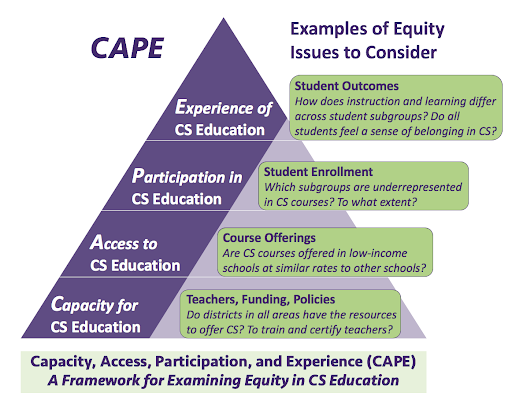True Equity is about more than just diversity in the classroom, and just because something is available to everyone doesn’t mean that everyone can or will benefit. Also, education is very complex and the things we can easily measure (such as AP class participation) may not be the best indicators of change or success.
We developed a new framework that reflects how things connect at different levels of CS education. Most importantly, this model helps us better understand how equity plays out at each level. We’ve called it the CAPE framework and it consists of four interdependent components: capacity for CS education, access to CS education, participation in CS education and experience of CS education.
Each level affects the next. For example, if we want students to have equitable experiences in CS, we first need to make sure they’re participating equitably. Equitable participation relies on equitable access and equitable access relies on equitable capacity.

CAPE is represented as a triangle with four levels. Capacity for CS Education is the foundational level of the triangle, with access to CS education above that, participation in CS education above that, and experiences of CS education at the top. Example questions that can be asked at the Capacity level address teachers, funding and policies such as Do districts in all areas have the resources to offer CS and to train and certify teachers? Access questions deal with course offerings such as Are CS courses offered in low-income schools at similar rates to other schools? Questions at the participation level address student enrollment such as Which subgroups are underrepresented in CS courses and to what extent? Experience level questions can address student outcomes such as How does instruction and learning differ across student subgroups and do all students feel a sense of belonging in CS?
The CAPE Framework helps the entire CS education community think about the systems they work in and the types of questions they should ask to ensure equity and inclusion in computing.
Article by Carol L. Fletcher, Ph.D. Read full article here.



